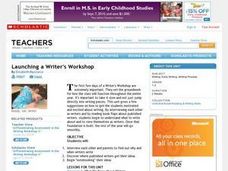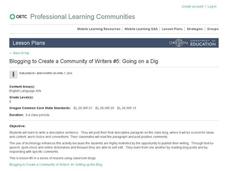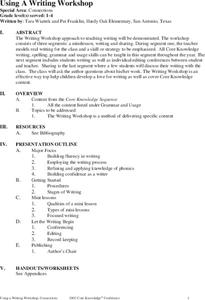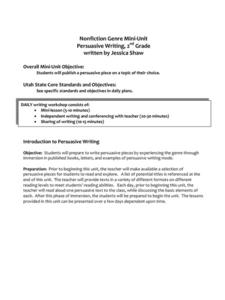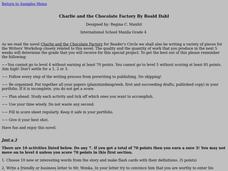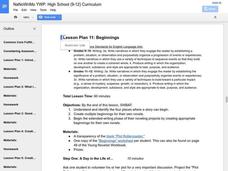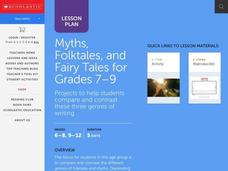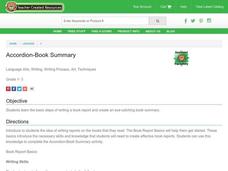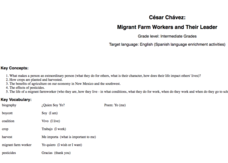Curated OER
Launching a Writer's Workshop
Students interview each other and their parents to examine why and when writers write and where published authors get their ideas. They complete a class T-chart, fill-out an interview worksheet, and read and discuss a variety of book...
Curated OER
Blogging To Create A Community of Writers # 5 of 7
Here is lesson 5 from a 7 lesson unit on using blogging to create a community of writers. The aim of this lesson is to get students writing about what Archaeologists do and how they use material data to study the past. They compose a...
Curated OER
Writer's Workshop
In this language arts worksheet, students are led through the process of a writers' workshop with an emphasis upon editing and publishing.
Curated OER
Using a Writing Workshop
Students observe modeling of the writing workshop. In this writing workshop lesson, students understand that the writing workshop will be taught throughout the year and each lesson will be a segment which will be discussed.
Curated OER
Nonfiction Genre Mini-Unit: Persuasive Writing
Should primary graders have their own computers? Should animals be kept in captivity? Young writers learn how to develop and support a claim in this short unit on persuasive writing.
Residential College in the Arts and Humanities
Poetry Lesson Plans
Need some ideas for poetry lessons? Check out this packet loaded with suggestions for elementary, middle, and high school writers.
Michigan Association of Intermediate School Administrators
Persuasive Essay: Grade 5
Improve your fifth graders' persuasive writing skills in four weeks. Working independently, in peer editing groups, and with instruction, writers work over the 17 sessions to craft an argumentative essay. They craft a...
Curated OER
Charlie and the Chocolate Factory
Fourth graders read the novel Charlie and the Chocolate Factory for Reader's Circle, they also are writing a variety of pieces for the Writer's Workshop that is closely related to the novel. The quality and the quantity of work that...
Curated OER
Lesson Plan 11: Beginnings
Every good novel needs a solid beginning! Setting the stage can have your budding authors stumped, so use this lesson to get them thinking. After examining the plot rollercoaster image (included) they consider the four places...
Curated OER
Lesson Plan 17: Novel, Take 2
It's all about using peer resources in this writing process lesson, which includes a fantastic novel revision worksheet packet. Learners have read a partner's story draft the night before, and groups have a "lightning round of...
Scholastic
Myths, Folktales, & Fairy Tales for Grades 7-9
Here is a must-have resource for studying fairy tales, myths, and folktales with your class! It includes instructional ideas, activities, and materials to support a month-long review of these three unique genres of writing.
Curated OER
Cite Right
What do you need to cite, and how can you avoid plagiarizing? This presentation is aimed at beginning writers, and it details some of the ways people plagiarize (even accidentally) and what sort of information needs to be cited. The...
Curated OER
Border Poetry/Writing Workshop
Students analyze a poem set in the U.S.-Mexico borderlands and defend their own interpretations of the work. They demonstrate understanding of poetic technique by writing their own poems of living on the border.
Curated OER
Accordion-Book Summary
Introduce your young readers to the book review. Groups of writers practice the basic steps of writing a book report and complete an Accordion-Book Summary activity. The lesson includes book report basics and directions to make...
Scholastic
Step-by-Step Strategies for Teaching Expository Writing
A carefully crafted, logically organized, 128-page packet is an excellent addition to your unit on expository writing.
Curated OER
Revolutions in Retrospect
Students analyze the social conditions of Victorian England and focus on the woman's place in Victorian society. In this Victorian England lesson, students read excerpts of Victorian writers and their take on the Industrial Revolution....
Curated OER
Rain Forest Writing
First graders have already examined the characteristics of the rainforest. They write a story about the rainforest and it can be fact or fiction. They type their story in the computer lab to be published.
Curated OER
Same Theme, Different Story Using Fox by Margaret Wild
Middle schoolers work with themes in this lesson, which is based on Fox by Margaret Wild. Because the book has multiple themes, it is a great way to transition into exploring literary analysis and writing stories. A Six Trait writing...
University of New Mexico
César Chávez: Migrant Farm Workers and Their Leader
During the first week of instruction, middle schoolers research biographies on Cesar Chavez and make a pictorial collage of his life. For the second and third week, they maintain a seven-day diary of a farmworker and write a poem. For...
Curated OER
When I Was Young in Brooklyn
Students identify various techniques used in memoirs. They reflect on similarities and differences betwee two authors. Students define the term memior. They write about various techiques they noticed the authors used. Students write...
Curated OER
Best Part of Me
Students find the best part of their body. In this positive self-concept lesson, students listen to the story The Best Part of Me. They come up with their best feature and write a poem about it.
Curated OER
Natural Disasters: An Adventure in Non-Fiction
Students study different natural disasters. In this natural disaster lesson students read a nonfiction book followed by a discussion, an experiment, then collect illustrations from their experience.
Curated OER
Revising/Editing (3-5): Editing Marks. Part II and Literary Tools. Part II
Familiarize your class with commonly used editing marks. They apply the use of editing marks to a letter and examine different types of literary tools before making a note card resource for the tools. They add their own examples for each...
Turabian Teacher Collaborative
Parts of Argument II: Article Critique
Break down the parts of argumentative writing with a critical thinking activity. High schoolers read an article of your (or their choice), and use a graphic organizer to delineate the ways the author structures his or her arguments.


